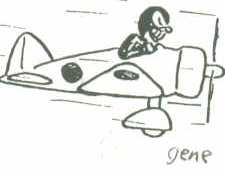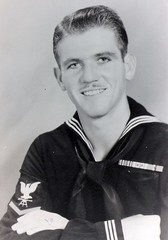Invasion of Iheya Retto (June 1945)
Our little armada of about 56 ships and landing craft is standing by to make another invasion try at Iheya Retto. It is very warm and cloudy and I bet the Marines crowded in those small boats are ready for something to happen. Let’s get it on or call it off.
On June 3rd we weigh anchor at 0215 and slip silently seaward sheparding our LSTs, LCIs and LCMs like a sheep dog. The night is pitch-dark with rain in the area and forming up is all done with the surface radar - destination is Iheya Retto - north of Point Bolo about 45-miles. We go to G.Q. at 0245 and the rains came - mighty uncomfortable topside - glad it’s not cold. When we arrive at Iheya Retto, five of the destroyers move in parallel to the beach and began laying down a barrage on the landing area. Troops began disembarking at exactly 1000. As planned, when the pre-landing bombardment of the beach is completed, the FOOTE immediately swings around the small island and established a Radar Picket Station opposite the beachhead so any planes coming down from Japan will see us first. We didn’t have to wait long - Bogies heading in at 1309. The overcast is very dense and very low. It will be very hard for the C.A.P. to pick up a Bogie visually. The USS O’BANNON (DD-450) and the USS PAUL HAMILTON (DD-590) joined us on station to provide more fire power. A Jap “Val” (Dive Bomber with fixed landing gear) came screaming down our port side at about 6,000-yards with four Corsairs on his tail - closing steadily. They were in and out of the low lying clouds until they disappeared and about five seconds later there was a big flash on the horizon - scratch one Bogie.
At 1341 we sighted another “Val” on the port side with that unmistakable fixed landing gear - our 5-inch and 40-MM guns opened fire at 4,000-yards. Suddenly, he dips his wing and turns off in a long sweeping dive at one of the other destroyers. The other two ships open fire - the “Val” is hit and aflame, but he never varies his course - misses the O’BANNON by yards throwing up a geyser of water as high as her mast.
At 1430 additional raids headed in were splashed by the Corsairs about eight miles out - if it was clear, it would be visible to us on the horizon. Those Marine Corsair pilots flying C.A.P. for us are doing a yeoman job - can you imagine what it would be like without them? We are picking up the incoming raids at about 50-miles and they come in like homing pigeons - their bearing never changes as much as one degree. With the incoming raid range down to 6,000-yards we still can’t see them. At 5,000-yatds - still not visible. (In clear weather, planes can be spotted at about 12,000 to 16,000 yards and 6,000-yards is considered “duck-soup” for the Main Battery.) When the Bogies are down to 4,000-yards, two Corsairs streak across our bow at about 400-knots and hightail it into the overcast. The topside crew members are real tense - everyone is holding their breath.
About 15-seconds later (which seems like forever) a ball of flame hurtles down off the starboard bow. In about another three seconds another Bogie goes down about a mile away. Reports from the Radio Shack indicate the C.A.P. has splashed 25 Bogies today and the Radar Picket destroyers got another five. After dark the area was clear of Bogies and the night was uneventful. A fellow can lose weight doing this kind of work.
On June 4th we are still patrolling on Radar Picket Station west of Iheya Retto and dawn breaks very cloudy with constant rain. We are on station with the USS PAUL HAMILTON and our “Pallbearers” are LCS-69 and LCS-95. The O’BANNON has been detached. We go to G.Q. at 0745 and again at 1020 - Bogies are in the area, but we can’t see them - good thing about it is they can’t see us either. The clouds are hanging right down on the water with almost constant rain. At 1030 LCS-69 and LCS-95 were detached and ordered to return to the Iheya Retta anchorage. We get the word at 1110 that typhoon warnings have been posted in the area (Iwo to Shanghai) - winds have picked up to about Force-4 on the Beaufort Scale. The Beaufort Scale goes from 0 to 12, with “0” being a calm, smooth, mirror-like sea. These twelve conditions are referred to as “Forces” and a Force-12 is a full blown typhoon. The descriptions are visual, not digital. Force-4 is a moderate wind, small waves, becoming longer with white caps. Around Force-8 you begin to have some sick sailors and feel a little anxious and foam is blown in well-defined streaks with the wind. In a Force-10 storm the official description calls for 30-foot seas where the “tumbling of the sea becomes heavy and shocking - the whole surface of the sea takes on a white appearance.”
At 1235 we are directed to immediately leave our Radar Picket Station and rejoin Task Group-31.25 and took station as A/S (Anti-Submarine) screen for the Task Group. The entire Task Group is underway at 1600 for a protected anchorage off Kouri Shima, on the northwest side of Okinawa - this is a land-locked bay called Nago Wan.
The typhoon doesn’t hit - it passes well to the east of us - winds never exceeded Force-4, so we stand out at 0400 with Task Group-31.25 and are directed to take up our old Radar Picket Station west of Iheya Retto. We are still under the low, ominous looking skies as the FOOTE and PAUL HAMILTON start patrolling our station on the. Japan side of Iheya Retto. The slower LCS-69 reported on station for duty as our “Pallbearer” at 1030. We went to G.Q. several times during the afternoon and evening when enemy aircraft approached, but we couldn’t see them and we didn’t fire. I love this lousy weather. The topside crew is wet constantly.
On the morning of June 6th we received a Commander Task Group-31.25 dispatch directing the FOOTE and CONVERSE to proceed to Kerama Retto to take on ammunition, fuel and stores - upon completion these vessels are to return to Iheya Retto. We departed our Radar Picket Station at 0600 when we were relieved by CHARLES AUSBURNE and joined CONVERSE en route to Kerama Retto. After nine hours of replenishment - hard work for most of the crew - we head back to Iheya Retto and anchored off the landing beach at 1817. G.Q. was sounded several times before the mid-watch, but we didn’t fire. The Radio Shack reports twelve Kamikaze were shot down in the last 24-hours.
We got underway at 0458 on the morning of June 8th in company with CONVERSE for our old Radar Picket Station. At 0543 the FOOTE and CONVERSE relieved CHARLES AUSBURNE and PAUL HAMILTON - USS DALY (DD-519) had joined them yesterday and she remains on station with us. (I learned after the war that I had a nephew serving on the DALY and neither of us knew what ship the other was in.) After only about seven hours on station the FOOTE, CONVERSE and DALY are directed to vacate the Picket Station and proceed to Hagushi Anchorage at Okinawa. Rumor has it we are standing by for the second invasion operation. Bogies approach the anchorage and we are at G.Q. from 1350 to 1910, then back to Battle Stations from 0210 to 0500 - this way nobody gets any sleep. The C.A.P. shot down ten planes in the past 24-hours.
The word is official, our little Task Group will support the landing and occupation of Aguni Shima - another of the little out-lying islands. All charts are made ready for the FOOTE’s role in the bombardment of the invasion beach. Reports are, there should be little or no resistance. Another land-based Radar Station will be installed to relieve the destroyers on Radar Picket duty. That’s a good deal. We went to G.Q. at 1110 and again at 1430 with lots of raids reported in the area, but none approached our anchorage. We went back to Battle Stations at 2015 with Bogies at 35-miles, headed in - this time one plane made it in to about 10,000-yards and was splashed astern of the FOOTE by the C.A.P. On the course he was holding he would have come right down our centerline in less than 2-minutes if a Corsair. had not nailed him - and us swinging on the hook. The FOOTE’s luck is holding pretty good.
(USS FOOTE Deck Log, USS FOOTE War Diary, USS FOOTE General Action Report and Gene Schnaubelt)
Written by: Wilbur V. Rogers




0 Comments:
Post a Comment
<< Home